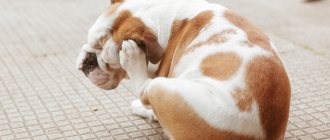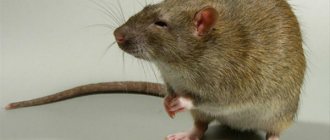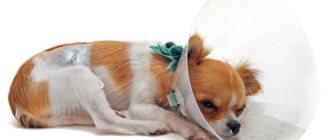Poisoning in dogs is not uncommon. Compared to other pets, they are indiscriminate in their food, and they have more opportunities to pick up poisonous bait. The result of intoxication may vary - from one-time vomiting to death. In case of severe poisoning, every minute counts, so the pet’s life depends on correctly provided first aid.
The owner of the animal must be able to notice signs of intoxication in time and know what to do if the dog is poisoned, especially when it is not possible to take the pet to the veterinarian and assistance must be provided at home.
How can a dog be poisoned?
In most cases, poison enters the animal’s body in three ways.
- The most common cause of dog poisoning is the dog eating poison. After this, toxins are absorbed from the stomach and intestines, the mucous membrane of the digestive tract is damaged, and the process of digesting food is disrupted.
- The dog inhales toxic fumes. In this case, toxins penetrate into the blood through the lungs, and the respiratory system suffers.
- The toxic substance is absorbed through the skin of the animal.
Once in the blood, toxins are distributed throughout the body. Depending on the type of poison, the heart and nervous system are affected. The liver and kidneys are always affected, as the main organs that neutralize the toxin.
The most common causes of poisoning in domestic dogs are as follows.
- Poor quality food. Typically, intoxication occurs as a result of picking up rotten meat or toxic substances from the ground. Sometimes the cause of food poisoning is spoiled ready-made dog food or leftover homemade food.
- Intentional poisoning by dog hunters. In such baits, isoniazid or rodent poisons are most often used.
- Incorrect use of veterinary drugs. This includes medications and remedies for parasites - worms, fleas, ticks. Poisoning can occur due to an overdose or an incorrectly selected drug. The dog licks off flea and tick medications that are incorrectly applied to the skin, resulting in poisoning.
- Human medicines from a home medicine cabinet. The animal may suffer as a result of the actions of its owners. Dogs have a different metabolism compared to humans. Harmless antipyretics from a home medicine cabinet can cause serious adverse reactions in them. Less commonly, accidental eating of pills left within reach is possible. Boric acid should not be used on dogs - it causes acute poisoning in the animal, which can be fatal.
- Poison for rats and mice. Currently, zoocoumarins are used to control rodents. This group of poisons causes blood clotting disorders, bleeding from natural orifices, and bruising on the skin. They have a cumulative effect. To poison a dog, you need a large dose or constant eating of baits, but it can become poisoned if it eats rodents that have died from the poison.
- Agricultural pesticides - insecticides, herbicides, fertilizers. They are used for treating seeds, wood, and spraying fields. Many are made with mercury or arsenic. Pesticides can contaminate soil and water if used, stored, and disposed of improperly.
- Household chemicals.
- Anti-ice reagents.
- Gasoline, kerosene, and paint vapors can poison a dog if it is indoors.
- Carbon monoxide.
- Petroleum products through the skin.
- Alcohol. Ethyl alcohol is a toxic compound for dogs. It should not be given to an animal in any form.
- Unsuitable products. These primarily include chewing gum and cheap sweets containing xylitol. You shouldn't give dogs chocolate. It contains the alkaloid theobromine, which is toxic to them. A bar weighing 100 grams can cause chocolate poisoning even in large breeds of dogs.
- Rarely, intoxication with poisonous herbs occurs, for example, with house plants - milkweed, dieffenbachia, rhododendron, daffodils, tulips, azalea.
Ready-made dog foods can also lead to poisoning if they were stored incorrectly or the manufacturer was unscrupulous in production controls. For example, dry foods may contain ergot alkaloids due to the use of contaminated grains. Dogs should not be given cat food, and when preparing their diet, age recommendations must be followed.
The main cause of poisoning in dogs is the inattention of owners during walks.
The first signs of poisoning
By nature, a dog is a scavenger. Therefore, he often suffers from eating stale food. The stomach juice of canine animals contains a large amount of hydrochloric acid, which allows it to digest stale meat. However, modern dogs are pampered, so their food instincts often fail them. Sour porridge or rotten meat picked up during a walk can cause disruption of the stomach and intestines. In puppies, the digestive tract is even more vulnerable.
The first signs of food poisoning in a dog are as follows:
- refusal to eat;
- lethargy;
- vomit;
- diarrhea.
Vomiting usually occurs once or twice until the stomach empties. Body temperature is usually within normal limits.
Mild food poisoning can be treated at home, but only if the owner knows exactly what poisoned the dog. It is necessary to carefully monitor all symptoms and their dynamics. If threatening signs appear, you should immediately contact a veterinarian.
Food poisoning can easily be confused with viral enteritis. Repeated vomiting of white foam, rapid increase in weakness, very loose stools are obvious symptoms of viral enteritis.
Possibly chronic food poisoning. In this case, the signs of intoxication will be erased - diarrhea alternating with constipation, deterioration of general condition, poor appetite.
If feeding is disrupted, dogs often develop protein poisoning. If the diet is too high in protein and lacks cereals and vegetables, then chronic intoxication occurs. Protein poisoning in a dog can be determined by the following signs:
- exhaustion;
- deterioration and hair loss;
- peeling of the skin, itching;
- diarrhea;
- changes in urine.
Protein poisoning develops over a month or more; signs of the onset of the disease increase gradually.
Symptoms of poisoning in dogs
The first signs of dog poisoning can vary significantly, as much depends on the type of poison. All types of pathology are characterized by the following symptoms:
- vomit;
- stool disorder;
- profuse salivation.
Other, less typical symptoms include:
- weakness, lack of appetite;
- body temperature is below normal;
- muscle tremors;
- pain in the abdominal area;
- convulsions (less often partial paralysis);
- the appearance of odor from the mouth;
- heart rhythm disturbance;
- dilation or constriction of the pupils, possible lack of reaction to light.
If food poisoning in dogs (from food) is usually accompanied by only the main signs, the ingestion of more potent toxins into the body can be determined by the clinical picture:
- Medicines cause overexcitation, followed by apathy and drowsiness. The pupils dilate, spatial coordination is impaired, and vomiting is present.
- In case of arsenic poisoning, a characteristic smell of garlic appears from the mouth.
- Poisonous plants cause increased heart rate, changes in the state of the pupils (in any direction), trembling and a drop in body temperature.
- Acids and alkalis primarily affect the larynx. It swells, it becomes difficult for the dog to breathe, he coughs, there is diarrhea, and vomiting is possible.
- Mercury is very toxic; when it comes into contact with mucous membranes, small ulcers appear. Severe vomiting, convulsions occur, followed by complete or partial paralysis. The condition is developing rapidly.
- Rat poison can be distinguished by the presence of blood impurities in all secretions: saliva, vomit, feces. The temperature rises, convulsions occur, after which the swallowing reflex may be absent. Note that the products containing the substance also differ. Some give a quick response, others cause only minor symptoms, such as Bromadiolone.
- If poisons were in the air, then the mucous membranes will become bright red (from a rush of blood). Saliva will be released profusely and tearing may occur. Breathing will become frequent and shallow, sometimes the animal loses consciousness.
- Another extremely dangerous type of poison is isoniazid (for example, sago palm or tubazid). Poisoning manifests itself as foam at the mouth with bloody splashes, the animal cannot stand on its paws and convulsions occur, movement coordination is lost, breathing is depressed, and there is a risk of falling into a coma.
- Brodifactum (a rodent control agent) reduces blood clotting, for this reason the clinical picture is complemented by frequent nosebleeds.
When the first unpleasant symptoms appear, be sure to call a doctor. Only a specialist can assess the danger of the situation.
Video: how to understand that a dog has been poisoned?
Symptoms
How can you tell if your dog is poisoned? Signs of intoxication can be general and specific, characteristic of a particular group of poisons.
Symptoms of poisoning in a dog are as follows.
- Vomiting, excessive salivation, foam at the mouth. In the vomit you can see what the dog ate, and by the smell you can determine what poison affected the animal. So, if it smells rotten, it means that the poisoning occurred from carrion, garlic - arsenic is to blame. Maybe the specific aroma of insecticides and petroleum products. Vomiting blood is a bad symptom. It occurs when the mucous membrane of the esophagus and stomach is severely damaged due to zoocoumarin poisoning. It may continue after the stomach has completely emptied. In this case, when a dog is poisoned, a small amount of foam is released from the mouth, sometimes mixed with bile.
- Refusal of food. In mild cases, there is a decrease in appetite, and in severe cases, the dog is not even able to drink.
- Painful, hard stomach. When you try to palpate it, the animal hunches over and is in pain.
- Loose stools. Bloody diarrhea in a dog develops when poisoned by rat poison. Frequent watery bowel movements may indicate enteroviral enteritis, which is sometimes confused with poisoning.
- Weakness. Develops as a result of poor condition and dehydration.
- Failure of a dog's hind legs during poisoning, convulsions of certain muscle groups, or if the animal is having a seizure - this may be a sign of damage to the nervous system by toxins. There is a lack of coordination of movements, an unsteady gait, and falling to one side.
- Trembling in a dog when poisoned can be a result of fear. If individual muscles twitch, for example, on the face or paws, then this indicates damage to the nervous system by the toxin.
- When a dog is poisoned, the body temperature can drop to 36 °C, for example, with boric acid intoxication, or rise with food poisoning or zoocoumarins. It may also be within normal limits.
- Specific signs of dog poisoning with rat poison (zoocoumarins) are pale mucous membranes, bruising on the skin, bleeding gums, blood from the mouth, nose and anus, brown urine.
In severe cases of dog poisoning, threatening symptoms develop - impaired breathing and heart rhythm, clouding of consciousness, coma. Some toxins cause dilated pupils, loss of vision, and urinary disturbances - involuntary due to damage to the nervous system, or in the form of anuria - lack of urine when kidney function is depressed.
Signs, symptoms and diagnosis
Symptoms of poisoning in dogs of mild or moderate intoxication will appear 7 hours after the poison enters the body. If the poisoning was severe, then this period will be reduced to 3 hours.
Under no circumstances should you treat an animal yourself, because the risk of worsening its condition by giving the wrong medicine is very high, and this can lead to the development of serious complications. Only a veterinarian can help here.
Common symptoms and signs of poisoning in dogs
Dog poisoning: general symptoms, namely those that appear every time with any type of poisoning. These include:
- loss of appetite, apathy, lethargy (the dog hardly moves, just lies down and that’s it) are the first signs of dog poisoning;
- loss of control over motor functions;
- frequent attacks of vomiting (sometimes with foam), lasting quite a long time;
- diarrhea;
- increased breathing rhythm;
- increased amount of saliva;
- change in heart rate (can be either slower or faster);
- uncharacteristic, often unpleasant odor from the mouth;
- change in color of the mucous membrane (takes on a yellow tint);
- involuntary emptying of the bladder;
- thirst that does not go away and does not become less strong, no matter how much the dog drinks.
This kind of thirst is included in the symptoms of a number of ailments; it is impossible to diagnose poisoning based on it.
For food poisoning
In this type of disease, the clinical picture is expressed by general symptoms , but there is an exception - poisoning caused by neglect of the diet. In this case, the animal does not receive the required amount of carbohydrates, but, on the contrary, consumes a lot of protein. Similar signs of poisoning in dogs occur when the dog is fed, for example, chicken meat, but is not given tripe.
Symptoms of protein poisoning in a dog as a result of poor diet are as follows:
- no matter how much a dog eats, it remains thin;
- the tail becomes bald, hair may fall out along the spine or on the face;
- urine becomes dark and acquires a repulsive odor;
- severe itching appears, the pet can scratch itself until it bleeds;
- the skin begins to peel off;
- The animal's fur becomes dull and becomes much tougher.
Signs of such poisoning do not appear for quite a long time (sometimes they do not appear for weeks), because the protein does not accumulate to a critical dose immediately. And during these weeks, the animal does not feel any discomfort.
For non-food poisoning
Depending on what substance caused the intoxication, the clinical picture will vary.
1. Signs of dog poisoning with drugs containing anabasine (products for processing vegetables or berries):
- vomiting does not stop;
- the mucous membranes of the tongue, eyelids and lips acquire a bluish tint;
- the dog’s consciousness is clouded – it doesn’t recognize anyone and doesn’t react to anything;
- Paralysis of the respiratory muscles and death quickly occur.
2. If an animal is poisoned by something that contains aniline (for example, a chemical pencil):
- vomiting, lethargy, the skin first turns pale, then gray-blue;
- the animal is breathing heavily, the pupils are dilated, the temperature is low;
- there is blood in the urine, urination is difficult;
- convulsions.
3. If the dog is poisoned by plants containing atropine (for example, henbane, belladonna or datura):
- vomiting, dilated pupils, barking becomes hoarse;
- hallucinations, both visual and auditory, rapid pulse;
- reddened skin on the abdomen, seizures as in epilepsy;
- death within a few hours after intoxication.
4. If the dog is poisoned by toxic fumes or gases :
- saliva flows, tears come, vomiting of blood begins;
- a cough and shortness of breath develop, the mucous membranes become bluish;
- lack of coordination of movements, especially gait.
5. If a dog is poisoned by arsenic (possibly when the animal is poisoned on purpose):
- the animal rubs its face, vomits profusely;
- diarrhea begins, stools are light;
- the barking becomes hoarse and soon becomes silent;
- convulsions and death.
6. Symptoms of a dog being poisoned by rat poison:
- lethargy, refusal to eat, possible vomiting;
- difficulty breathing, coughing;
- a characteristic sign is bleeding from the anus, bleeding in the whites of the eyes;
- convulsions, loss of consciousness.
First aid
Poisons can act very quickly, literally within 20–30 minutes. Therefore, when a dog is poisoned, it is often necessary to provide first aid at the scene of the incident, usually this happens at home. However, in any case, you should then contact a veterinarian.
The procedure for providing first aid to a dog in case of poisoning is as follows.
- Stop contact with poison. If the toxin enters the body through food, induce vomiting. If poison gets on the skin, wash the dog with warm water and baby soap. If poisoning occurs due to inhalation of toxic fumes, take the pet out of the room to the street or onto the balcony and provide access to air. In case of carbon monoxide poisoning, wash the mucous membranes of the mouth and eyes with a 3% solution of baking soda.
- Give sorbents - activated carbon in the form of a solution of 1-3 g per 1 kg of weight. Half an hour after removing the adsorbent, give a laxative and enveloping agent.
- In case of vomiting, make sure that the vomit does not enter the windpipe.
After providing first aid, you need to take your pet to the veterinarian or call him at home.
Treatment and first aid
First aid and a set of subsequent measures are selected for a specific case. But the general plan is the same. Before the doctor arrives, you need to calm your pet, do not panic, and cleanse the body of poison:
- Eliminating the effect of the toxin (washing the dog’s stomach in case of food poisoning, treating the bite site, rinsing the skin or fur in the case of using poisonous shampoos or medications; access to clean air when inhaling toxic fumes);
- Removing poison from the entire body (rinsing the mouth, enema);
- Call a veterinarian;
- Administration of an antidote or antacid (phosphalugel, activated carbon, injections);
- Use of a diuretic;
- Restoring breathing, muscle tone (relieving cramps);
- Prescription of procedures that support the functioning of the liver, kidneys, stomach, and immune system;
- Development of an antibiotic or other follow-up treatment program.
What to do at home
If it is not possible to quickly get to the clinic, then you need to act independently according to the plan. The sooner treatment begins, the higher the pet's chances of survival, especially in the case of chemical poisoning.
The first point is washing the stomach, intestines, mouth, skin, fur, and all parts of the body susceptible to poison. Vomiting is provoked (a glass of water + a spoon of salt; a glass of water + a glass of peroxide), the mixture is sharply poured in one go into the cleaned mouth of the animal. It is forbidden to induce vomiting in case of poisoning with acids, alkalis, or oil; such a procedure will provoke destruction of the mucous membrane or re-poisoning.
The poison is effectively removed by absorbents - Enterosgel, activated carbon, Enterosorb, Polyphepan. To cleanse the intestines, give vegetable oil (1 tablespoon) or a laxative; give an enema with water or chamomile infusion.
Ice is applied to the bite or puncture site. Cold causes vasoconstriction and slows down the spread of toxins through the blood. The antidote can only be obtained at a clinic or pharmacy, but you will need to consult a veterinarian.
What to give
Of course, with ordinary poisoning, any human preparation will help (gels, powders - Atoxil, coal). Only a veterinarian can determine what to give in case of poisoning with specific poisons, having developed a complete treatment and recovery program. As first aid, injections or solutions are administered.
| Type of poisoning | Medicine | Dose |
| Rat poison | Vitamin K or Vikasol | Intramuscularly 1-2 ml |
| Isoniazid | Pyridoxine (injection) (1%) | 10 ml per 30 kg |
| Arsenic | Ferrous sulfate + magnesium oxide | Soldering with solution |
| Acid | Any adsorbent, drink plenty of fluids | Soldering |
| Snake or spider venom | Antidote serum | Inside |
It is imperative to eliminate not only the poisoning itself, but also the side symptoms. So, to stop vomiting, give flaxseed, raw protein, starch solution. Internal bleeding is stopped by nettle infusion. Heals wounds after a bite - antiseptic and chamomile solution. To restore stool regularity - a tablespoon of vegetable oil, to consolidate stool - drink plenty of fluids, activated charcoal.
Care after poisoning
After all symptoms have been eliminated, recovery and special measures to care for the animal are needed. Firstly, a ten-day diet is maintained. On the first day, it is better to withstand fasting; the introduction of food is allowed in the complete absence of blood discharge. If there is internal bleeding, feeding will worsen the situation.
After 2-3 days, light meat broths, low-fat kefir with buckwheat, and bread crumb are introduced. The portion is divided into 4 doses. If the dog eats willingly and recovers quickly, you can give boiled lean meat, oatmeal, cottage cheese, and steamed vegetables.
How to flush a dog's stomach at home
To induce vomiting in a dog, it must be given a solution of table salt or baking soda diluted with 1 tbsp. l. per glass of water. Or dilute 3% hydrogen peroxide in half with water. For small dogs the solution is administered from a syringe or spoon, and for large breeds from a syringe. It is better if the liquid is warm.
Soldering technique:
- close your mouth;
- raise your head a little;
- Insert the tip of the syringe into the corner of your mouth and pour little by little behind your cheek, allowing you to swallow.
Two more ways to induce vomiting in a dog:
- press the root of the tongue with your fingers, preferably wrapping your hand in gauze or a clean rag;
- sprinkle a pinch of salt or soda on the root of the tongue.
How to rinse a dog's stomach at home if it is poisoned? At the clinic, a probe is inserted into the animal and washed through it. This procedure cannot be carried out at home without appropriate preparation. They use another method - using the same solutions that induce vomiting, only they need to be poured in larger quantities, approximately 100 ml per 10 kg of animal weight. When the dog vomits, repeat the procedure again. Instead of emetic solutions, you can pour in potassium permanganate or sorbents.
Attention! - in some cases it is impossible to provoke vomiting:
- in case of poisoning with petroleum products, concentrated alkalis and acids;
- in case of loss of consciousness or convulsions.
It should be borne in mind that the rate of absorption of different poisons in the stomach may differ and occur from 15 minutes to 2 hours. After this, inducing vomiting is ineffective, since the toxin has already been absorbed. However, some of it can be neutralized in the intestines by giving the dog adsorbents.
How to make a dog vomit
First aid for a puppy in case of poisoning
If a puppy is poisoned, treatment will work better the sooner it is started. It is necessary to take first aid measures aimed at stopping the flow of poison into the blood.
Induce vomiting by having the puppy swallow one of the following solutions:
- table salt or baking soda - 1 tablespoon per glass of water;
- dilute a three percent solution of hydrogen peroxide with water in a 1:1 ratio;
- weak pink solution of potassium permanganate.
All solutions must be warm.
If exposed to harmful gases, remove the dog to fresh air. If the puppy has been exposed to carbon monoxide poisoning, wash the mucous membranes of the mouth and tongue generously with a 2% solution of baking soda.
If the poison acts through the skin (flea medications, petroleum products), then you should wash the puppy in warm water with baby soap.
Do not induce vomiting in case of poisoning with acids, alkalis, or petroleum products.
It is necessary to seek qualified medical help.
Treatment in hospital
In a veterinary clinic, treatment of poisoning in a dog is carried out as follows:
- wash the stomach through a tube;
- give a deep cleansing enema;
- an antidote is administered (if it exists);
- if necessary, a drip is placed to enhance urination and remove poison (forced diuresis), and to eliminate dehydration and normalize salt balance.
And also, depending on the indications, medications are administered - cardiac, respiratory stimulants, anticonvulsants, antiemetics, hepatoprotectors, antispasmodics, antibacterial drugs.
The danger of rat poison
Sometimes trouble comes from where you didn't expect it. A poisoned rodent does not die immediately and sometimes travels considerable distances, that is, it can come from neighbors. By instinct, your pet can catch it. The dog ate a poisoned rat - what to do? It's good if you noticed this. It's time to take measures to cleanse the stomach of food that has entered it, as well as detoxification. It is much worse if the poison has managed to be absorbed into the blood and act. In this case, success will depend on how quickly treatment is started. After providing first aid, be sure to take your pet to the veterinarian. It is best to leave him in the clinic for a day so that he can be under the supervision of a specialist and undergo a course of preventive measures.
I would like to note that there are many poisons for rodents. This is the main difficulty, since it is too late to conduct an examination if the dog has eaten a poisoned mouse. What should the owner do? Try to induce vomiting as soon as possible and take your pet to a doctor. Depending on the clinical symptoms, a specialist can guess what kind of poison the mouse was poisoned with and take action.
Treatment at home
Sometimes the owner is forced to carry out treatment measures on his own if it is not possible to quickly deliver the pet to a veterinarian. You can also treat food poisoning in dogs at home if the poisonous substance is known exactly, the animal’s condition is generally good, and there is no prognosis for deterioration.
If it is not possible to take your dog to a veterinarian, then a good solution would be to consult a doctor by phone. The owner will be required to correctly describe the symptoms, and, if possible, name the time of poisoning, the type of poison, and its estimated amount. If the dog has been poisoned by a medicine, then say its name (preferably according to the active substance, which is indicated in the instructions) and dose.
How to treat a dog with poisoning at home? After providing first aid, you need to give her a sorbent. Before use, the powders are diluted in a small amount of water. The course of treatment is from 2 to 7 days.
The list of sorbents for dogs in case of poisoning is as follows.
- "Enterosgel" 1 teaspoon per 20 kg of animal weight. Give from a spoon or dilute with water 1:3 and pour into the mouth from a syringe without a needle.
- In case of poisoning, a dog is given activated carbon at the rate of 1–3 g per 1 kg of weight. The tablets must be crushed and diluted in a small amount of water to form a suspension.
- "Polyphepan" - 0.5–1 g per 1 kg of weight.
- "Polysorb MP" - 0.1 g per 1 kg of weight.
Enterosorbents should not be used for gastric and intestinal bleeding!
What to do if your dog vomits due to poisoning? Give her a solution with an adsorbent. If she vomits again, then repeat it - there will be no harm. If the stomach has already cleared, but the dog continues to vomit, then you can stop the gag reflex with the help of an antiemetic drug - “Cerucal”.
If there is no diarrhea, then 0.5–1 hour after the enterosorbent, give the dog laxatives to cleanse the intestines, preferably saline ones - Glauber's salt or Carlsbad salt at the rate of 1.5 g per 1 kg of weight. The powder is diluted with water to a 6% solution. Oil laxatives are allowed to be given to dogs if there are no contraindications. They cannot be used in case of poisoning by poisons soluble in oils - organophosphorus or organochlorine compounds, most insecticides. It is better to use Vaseline oil in a dosage of 1 tbsp. l. for 20 kg of weight.
Enveloping agents - egg white diluted 1:1 with water, flaxseed decoction, liquid starch paste. Milk should not be given unless the dog has been poisoned by lead and mercury salts.
Diuretics (Furosemide) can only be given after consultation with a veterinarian, as there is a risk of kidney damage.
In case of food poisoning, drinking plenty of fluids is necessary to restore the water-salt balance. How to water your dog? If there was vomiting, then it is better to use solutions for oral rehydration - “Regidron”, “Hydrovit”. They contain salts necessary for the body. You can make a similar solution yourself - for 1 liter of boiled water, 1 tbsp. l. sugar, 1 tsp. salt. Drink in a dosage of 10 ml per 1 kg of weight. In case of vomiting, the dose is doubled. As a last resort, you can drink regular boiled water.
What to do if after poisoning the dog does not eat or drink anything? It is necessary to replenish fluid using intravenous infusions. If this is not possible, then the solution is injected subcutaneously. Use sodium chloride, Ringer's solution or 5% glucose. The needle is inserted into the withers area. To relieve intoxication in a dog, 20–30 ml of solution per 1 kg per day is required. This dose is divided into 2-3 infusions.
You should not feed your dog for 1–2 days after poisoning. The animal should only receive water.
First aid rules
If you suspect intoxication, you should call your veterinarian for emergency advice. The specialist will explain how to help the dog. At the same time, you need to try to determine the potential type of toxic substance, its possible dose and the approximate time of poisoning. The procedure for providing first aid will depend on the type of toxic substance.
In case of poisoning with rodenticides, products with ethylene glycol, NSAIDs, painkillers with acetaminophen, it is necessary to induce vomiting in the animal. Only water at room temperature can be used.
Liquid is poured in large quantities into the esophagus. Hydrogen peroxide at a concentration of 1.5% is used with caution to induce vomiting in dogs. It is mixed with water in equal proportions. The dosage of the solution is calculated taking into account body weight: for every 5 kg, 1 tsp is required. liquids.
Apomorphine hydrochloride will help induce vomiting in your dog. It is administered intramuscularly or subcutaneously. The dosage is 0.004 and 0.008 mg per kg. The drug should be used after consulting a doctor. You cannot induce vomiting in case of confusion, laryngeal paralysis, or seizures. Contraindication: poisoning with alkali and other caustic substances.
Further stages of assistance in case of poisoning:
- gastric lavage;
- use of adsorbents and laxatives;
- colon cleansing with an enema.
First aid rules for poisoning with other types of toxic substances:
- Medicines containing acetaminophen. The dog is injected with N-acetylcysteine.
- NSAIDs. The animal should have its stomach rinsed.
- Isoniazid. The pet needs to be given pyridoxine. Then they induce vomiting and give adsorbents and laxative salts.
- Bromethalin. Induce vomiting, wash the stomach and give a laxative. There is no necessary antidote.
Products that should always be in your home medicine cabinet to combat intoxication:
- Vitamin B6 (pyridoxine). For animals weighing up to 20 kg, 3-4 ml of the substance is needed, and for dogs heavier than 40 kg - 7 ml. For small breeds, 1.5–2 ml is required. The drug is administered intramuscularly. It is necessary to give an injection without additional diagnostics immediately if vomiting or loss of coordination occurs. After administration of the drug, the dog must be taken to the veterinary clinic within 20 minutes. Experts advise drawing the required amount of pyridoxine into a syringe and carrying the drug with you while walking. It can be used preventively - pyroxidine will not harm the health of your pet.
- Vitamin K1 (phytomenadione). Antidote for anticoagulant rodenticides. It is administered intramuscularly. The dosage is 5 mg per kg. The substance is part of the drugs K-Ject and Konakion.
- Adsorbents (activated carbon, Enterosgel, Enterozoo).
- Laxative salt (magnesium and sodium sulfate).
- Vikasol. Used as an analogue of phytomenadione.
After providing first aid, the dog must be taken to the veterinary clinic. It is advisable to take a sample of the suspected toxic substance with you.
Antidotes for dogs
What medicine should I give my dog if he is poisoned by specific poisons? The following recommendations can be done at home.
- When a dog is poisoned with isoniazid, the antidote is vitamin B6 (pyridoxine hydrochloride). It is administered intravenously to large dogs in the amount of 30–50 ml of a 1% solution. You may need up to 6 packs of 10 ampoules. If you do not have the skill of intravenous administration, inject intramuscularly.
- What vitamins should I give my dog if he is poisoned by rat poison? A specific antidote to zoocoumarins is vitamin K1 (Phytomenadionum). It is injected subcutaneously into the withers area in a dose of 1–2 ml.
- In case of poisoning with caustic acids or alkalis, one should not induce vomiting. It is also not recommended to give soda or citric acid. The dog’s nose, mouth, and tongue are washed with plenty of water and given 0.5–1 liter of liquid with an adsorbent. The animal needs to rinse its stomach through a tube.
- How to cure a dog from arsenic-based poison? With such poisoning, a faint garlicky odor emanates from its mouth. A specific antidote to arsenic is Unithiol. It is given to the dog in the form of a 10% solution, in an amount of 0.5 ml per kg of weight.
Doing an enema at home if a dog is poisoned is not advisable. It doesn’t always help, and sometimes it’s simply impossible to do it, and besides, for a deep enema you need to have the appropriate equipment.
What to do if your dog is poisoned?
Only a specialist should decide how to treat a dog in case of poisoning, since each poison is unique and requires specific therapy. At home, you can only provide first aid. This is important, since often it allows not only to alleviate the animal’s condition, but also to gain valuable time and prevent further spread of the poison.
First aid
Emergency measures may vary depending on whether you saw what the dog was poisoned with or you are struggling with signs of intoxication that have already appeared. If you know the cause of a pathological condition, first eliminate it. That is, it is necessary to stop contact with poison or toxin, wash the fur if it was on the skin, ventilate the room if a dangerous substance was in the air.
If you witness an animal eat poison, you can induce vomiting. To do this, fix the dog, open its mouth and lightly press on the root of the tongue.
You cannot provoke a gag reflex if acids, alkalis or petroleum products have been swallowed. When passing back through the esophagus, tissue damage will occur again.
If more than two hours have passed since the toxin entered the body, characteristic symptoms have appeared, there is no point in causing stomach contractions, the poison has already entered the blood. Your main task is to deliver your pet to the clinic. Until this moment, you can alleviate his condition. What to give your dog if he is poisoned:
- If suffocating with gas, give the dog the opportunity to breathe fresh air, wipe the mucous membranes with a soda solution (1 teaspoon per 100 ml of warm water).
- Sodium carbonate will also help with acid getting into the stomach. 1 tsp. dilute soda in a glass of water, give the solution to the animal (you can inject it using a syringe without a needle).
- With alkaline poisoning, on the contrary, you need to create an acidic environment. Give the dog a solution of lemon juice (take 2.5 tablespoons of lemon juice for 3 tablespoons of water).
- If your pet has swallowed medication, the best treatment is to induce vomiting and drink plenty of fluids. Try to find out what exactly the dog ate; the doctor will need this information.
- In case of food poisoning, you also need to rinse the stomach, give plenty of fluids and absorbents. You can use activated carbon, Polysorb or Enterosgel.
- When the cause of the pathology is mercury, the dog needs to be taken outside as soon as possible, pour egg white or activated carbon solution into the mouth (tablets at the rate of 1 tablet per 10 kg of weight are crushed and diluted with a small amount of water).
It is much more difficult to provide first aid to a dog in case of poisoning, since you need to know exactly what has entered the body. If you have this information and you need to know what to do if there is no doctor, use the following table:
| Cause of poisoning | Medicine | Directions for use/dosage |
| Rat poison | Vikasol or Vitamin K | Intramuscular injection 1-2 ml |
| Isoniazid | Pyridoxine (1%) | Injection at the rate of 10 ml. for 30 kg. |
| Arsenic | Ferrous sulfate + magnesium oxide | Soldering with solution |
| Poisonous spider or snake bite | Specific antidote | Inside |
Do not resort to traditional methods of treatment, for example, giving vodka to animals is strictly prohibited. Ethanol itself is a poison.
Visit to the veterinarian
When contacting a veterinarian, you need to give him as much information as possible: what the pet was supposedly poisoned with, when the first symptoms appeared, what they are, how rapidly the condition develops, what measures you have already taken.
The doctor will assess the criticality of the condition and decide on emergency measures. Antishock therapy is usually used, and detoxification drips are placed. Their composition depends on what poison has entered the body.
The number of droppers and the duration of their use depends on the severity of the dog’s condition.
The "cocktail" used in IVs may be unique. It will depend on the symptoms and the type of toxin. The most commonly used medications are:
- Solutions for drip administration: glucose 40%, Ringer-Locke solution, Nelit.
- Diphenhydramine with analgin is used to reduce temperature.
- No-shpa or Baralgin is used to relieve spasms.
- In critical cases, antishock therapy drugs are included: Prednisolone or Dexamethasone.
- To maintain liver function, hepatoprotectors are added: Essentiale (intravenous).
- Cordiamine, Sulfocamphocaine, Caffeine stabilize cardiac function.
- For severe vomiting, Cerucal is given.
- To maintain the functions of the digestive and excretory system, homeopathy is given: Veracol, Liarsin, Hepatoject.
- Furosemide is prescribed as a diuretic.
- Vitamin complexes help to recover and improve the general condition: Gamavit, Katazol, Vitam, vitamin C.
Isoniazid poisoning in dogs requires immediate treatment. The substance begins to act within 30–120 minutes. Vitamin B6 is urgently prescribed; in this case it acts as an antidote. Its dose depends on the amount of isoniazid consumed.
Feeding a dog after poisoning
When poisoning occurs and poison enters a dog’s body, the dog’s digestive and nervous systems, heart, liver, and kidneys suffer. Therefore, even with rapid healing, the animal will continue to experience weakness for some time.
To support your pet’s body, you need to limit its loads and follow a diet. For the first day, the animal cannot be fed at all, only drinking is allowed. Then you need to stick to your diet.
The rules for feeding a dog after poisoning are as follows.
- Mode. Food is given 4–5 times a day, with breaks between meals of at least 2 hours. You cannot force feed an animal, persuade it to eat or give it “snacks”.
- You need to start feeding with liquid food - broths, liquid porridge (rice, buckwheat, oatmeal). Warm the portion to room temperature.
- In the diet, use approximately 65% protein foods, 35% cereals and vegetables.
- Give lean meat (beef, chicken), boiled and twisted.
- Boiled eggs are allowed, the yolk can be raw.
- Fish - boiled and twisted, without bones.
- Vegetables include boiled beets and carrots.
- Fermented milk products - bifidokefir, fermented baked milk, cottage cheese.
They also give a little raw food to stimulate the secretion of digestive juices.
After poisoning, the dog must be excluded from the diet:
- fats (a little butter is allowed);
- milk (only for puppies up to 3 months);
- smoked meats;
- canned food;
- bread;
- sweet.
It is not advisable to give ready-made food, as it contains additives, preservatives, and does not contain natural digestive stimulants. Dry food is strictly prohibited, wet food only as a last resort. If necessary, it is better to feed food intended for animals with sensitive digestion - Royal Canin Gastro Intestinal or Purina Veterinary Diets EN Gastroenteric.
The return to normal feeding is carried out gradually, over 1-3 weeks, depending on the pet’s condition.
Causes
There are the following ways that poisons enter a dog’s body:
- Oral.
- Contact
- Respiratory.
- Arthropod and snake bites.
The oral method involves eating spoiled foods, household chemicals, poisoned rodents, and carrion. A dog can become poisoned when licking objects in the garden or vegetable garden after treating plants with herbicides before the working solution dries. An owner can poison a dog with an overdose of a drug, for example, during deworming.
recommended articles:
- Ascites or dropsy in a dog
- How to treat intestinal obstruction in a dog?
Contact poisoning occurs when toxic substances are absorbed through the skin, for example, during flea treatment.
Toxic gases—gasoline vapor or carbon monoxide—penetrate into the bloodstream through the respiratory system.
While walking or hunting, dogs are attacked by insects and reptiles, whose bites cause toxicosis.
Dog eats a rat










